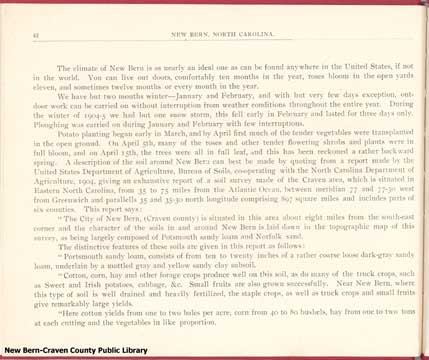
What New Bern Has To Offer You, Page 44
Click on an image below for more detail.
 |
Next Page---> | |
|
The climate of New Bern is as nearly an ideal one as can be found anywhere
in the United States, if not in the world. You can live out doors,
comfortably ten months in the year, roses bloom in the open yards eleven,
and sometimes twelve months or every month in the year. We have but two winter months--January and February, and with but very few days exception, outdoor work can be carried on without interruption from weather conditions throughout the entire year. During the winter of 1904-5 we had but one snow storm, this fell early in February and lasted for three days only. Ploughing was carried on during January and February with few interruptions. Potato planting began early in March, and by April first much of the tender vegetables were transplanted in the open ground. On April 5th, many of the roses and other tender flowering shrubs and plants were in full bloom, and on April 15th, the trees were all in full leaf, and this has been reckoned a rather backward spring. A description of the soil around New Bern can best be made by quoting from a report made by the United States Department of Agriculture, Bureau of Soils, co-operating with the North Carolina Department of Agriculture, 1904, giving an exhaustive report of a soil survey made of the Craven area, which is situated in Eastern North Carolina from 35 to 75 miles from the Atlantic Ocean, between meridian 77 and 77-30 west from Greenwich and parallells 35 and 35-30 north longitude comprising 897 square miles and includes parts of six counties. This report sys: "The City of New Bern, (Craven County) is situated in this area about eight miles from the south-east corner and the character of the soils in and around New Bern is laid down in the topographic map of this survey, as being largely composed of Potsmouth sandy loam and Norfolk sand. The distinctive features of these soils are given in this report as follows: "Portsmouth sandy loam, consists of from ten to twenty inches of a rather coarse loose dark-gray sandy loam, underlain by a mottled gray and yellow sandy clay subsoil. "Cotton, corn, hay and other forage crops produce well on this soil, as do many of the truck crops, such as Sweet and Irish potatoes, cabbage, &c. Small fruits are also grown successfully. Near New Bern, where this type of soil is well drained and heavily fertilized, the staple crops, as well as truck crops and small fruits give remarkably large yields. "Here cotton yields from one to two bales per acre, corn from 40 to 80 bushels, hay from one to two tons at each cutting and the vegetables in like proportion. |
||
Return to:
Craven County Digital History Exhibit
Return to: Ephemera Section of Digital History Exhibit
Return to:
Kellenberger Room
Images scanned by John B. Green, III. Text prepared by
John B. Green, III and Victor T. Jones, Jr.
This page last edited on
August 21, 2018.



